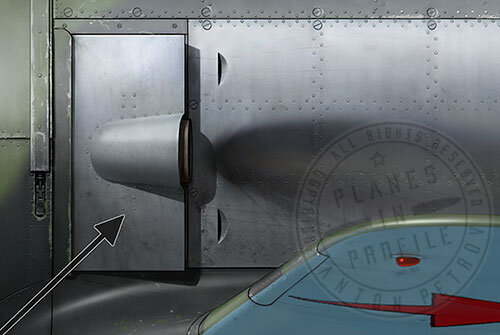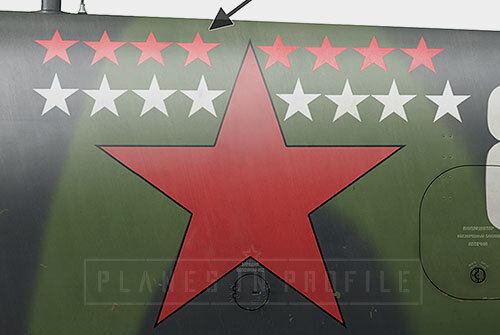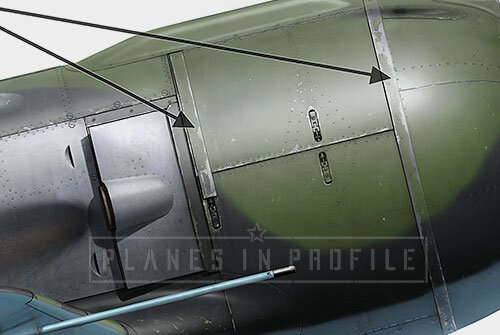Borisov’s White-86
LAVOCHKIN, LA-5 (TYPE 37)
21-st IAP, 259-th IAD, 3-rd Air Army, Kalininskiy Front, circa September 1943
Flown by the commander of the 2-nd squadron, captain Ivan Timofeevich Borisov. Ace with 8-21 air victories (depending on the source).
Please note! Extremely limited amount of photo reference exists (or could be found) for White-86. Therefore much of the artwork on this page is hypothetical.
Ivan Borisov fought in the Great patriotic War from the day it began on the 22nd of June 1941. Until 25th of September he commanded a flight of the 44-th IAP(3-rd IAD, Northern zone PVO and 7-th IAK PVO, VVS Leningradskiy Front) where he flew an I-16. From October 1941 he fought as part of the 193-rd IAP (Kalininskiy Front) where he flew a LaGG-3. From April 1943 he was a deputy commander of a squadron of the 21-st IAP(VVS of Kalininskiy and 1-st Pre-Baltic Fronts), and from the 3-rd of August a commander of the 2-nd squadron, flying the La-5. [2]. The regiment started to fly the La-5 planes in combat from April 1943.[3]
By September 1943 Borisov flew 329 battle sorties, out of which 45 involved the storming of enemy troops and equipment. By this time he scored 8 personal victories and 8 shared (victories vary depending on the source). For this he was awarded his second Order of the Red Banner decoration. [4] The profile artwork of White-86 above portrays it from roughly around this time, based on the 8 personal and 8 shared victory markings displayed on the fuselage.
A book by Ivan Kurguzov called ‘Звезды над Прибалтикой’ (Stars over pre-Baltic) describes one of Borisov’s acts of courage from roughly around the time when his White-86 looked as it does in the artwork above:
On 16-th of August 1943 Borisov led six Lavochkins to intercept Hitler’s bombers. Even from afar our pilots could already see a few groups of ‘Junkers’ which echeloned in altitude above ground, as well as twenty FW-190, moving from the west towards the front line. Gaining altitude and approaching from the direction of the sun, Ivan Timofeevich commanded:
-After me, attack! We fight until complete victory!
Borisov’s men bravely rushed into battle with a numerically superior adversary. Fascists did not expect that a small group of Soviet pilots would dare to be so desperately audacious. ‘Lavochkins’ moved to the side, maneuvered along the course, then sneaked up on the fascists from the direction of the sun and struck them with a hurricane of rounds. Two ‘Junkers’, downed with well aimed lead, emitting violet fans of smoke sunk towards the ground. Angered fascists all piled onto Borisov’s group like an avalanche. But our pilots managed to get away from the deadly head-on attacks of the enemy. And after a minute, having turned around, they directed their biting jets of counter fire at the enemy. Battle success of Borisov’s group inspired the personnel of the whole division. Battle leaflets reporting about the victory of the six fighters appeared everywhere.
By August 1944, Borisov was a deputy commander of the 976th Fighter Aviation Regiment (259th Fighter Aviation Division, 3rd Air Army, 1st Baltic Front), flying a Yak-9. Major I. T. Borisov performed 434 sorties, shot down about 21 airplanes (12 personal and 9 group victories - Please note that these victories are based on the information in Borisov’s award list. M.Bykov’s research indicates 5 personal and 3 shared victories instead). For these achievements Borisov was considered for the potential title of the Hero of the Soviet Union. [2] Part of the application for his H.S.U. title written by his commander, read:
‘In air battles Comrade Borisov displayed himself as a fearless fighter pilot, a strong-willed commander and a master of air battle. He displayed his audacity, courage and fortitude during battle to the whole personnel. Skilfully and decisively he attacks German vultures, regardless of their superiority, and always comes out victorious’. [4]
While Borisov’s title for the Hero of the Soviet Union was being considered, on October 19, 1944, while flying a Po-2 aircraft he did not arrive to his destination. On January 23, 1945, he was officially listed as Missing In Action. As it turns out, his airplane was shot down, though Borisov survived. Unconscious, he was captured by the Germans and was sent to a German P.O.W. camp. Some sources say that he eventually escaped and others that he was liberated. Either way, he re-united with the Red Army. On June 29, 1946, after passing all the checks(like most of the former prisoners of war), he was transferred to the reserve.
He tried for many years to restore justice and get his deserved title of the Hero of the Soviet Union, but died in 1980 without receiving it.
Noteworthy Visual Characteristics
General) Given the time period and photo reference, there is little doubt about the fact that the plane was painted with the usual Green/Black camo pattern, with the stars in the usual 6 positions. Though the photo quality is quite poor, there aren’t any obvious signs of wear and tear visible on this airplane, for example the canopy frame seems to not have any obvious paint chipping marks on it.
1) The cowl flaps of White-86 might have been unpainted.
This assumption is based on the fact that photos of other La-5s from the 21-st IAP have unpainted flaps. You can see one HERE and one HERE. No photos showing White-86’s exhaust flaps could be found (They probably doesn’t exist)
2) The 16 stars represent Borisov’s personal (red stars) and shared (white stars) victories which he achieved at the time of the photograph, most likely sometime around September 1943.
The actual amount of victories scored by Borisov by September 1943, and during WW2 in general, varies depending on the source. Some official sources state that he scored 12 personal and 9 shared victories, 21 in total during the war[1]. Mikhail Bykov’s research however, indicates that he scored 8 victories in total, 5 personal and 3 shared in WW2. The last of these was scored in September 1943- around the time when the photo of White-86 with 16 victory stars was taken.
(2a) Note that the red stars in the photo reference appear to be lighter than the large fuselage star. This might be because the smaller stars were of course painted later and the newer red paint might be more reflective, or it could actually have been a lighter shade of red.
(2b) There is a chance that the victory stars were repeated on the right side of the airplane. No photos of White-86 were found to confirm whether it had these markings on the right side or not, but we do have photos of some other airplanes from the 21-st IAP which do show victory markings on the right side. These photos can be seen on ava.org.ru, or by clicking HERE and HERE.
It’s not often that the victory markings were displayed on both sides of the plane, they usually appeared only on the left side, so the right side of White-86 might have looked as per Option ‘1’ in the illustration below.
. However, the practice of displaying victory markings on both sides of the plane was observed in some regiments. And this might have also been common practice in the 21-st IAP.
3) The cowl bands were probably painted. The paint might have chipped off them due to wear and tear, exposing some bare metal. This presumption is based on the same photo reference of La-5s from 21st IAP as was used to determine the colour of the exhaust flap in point #1.
4) Thought it’s not visible in the photo of White-86, the airplane was most certainly painted with the standard Green/Black camouflage. There is a good chance that it might have been covered with MK-7 temporary white paint over the top of the standard Green/Black camo originally, but the photo doesn’t seem to show any traces of it left on the airplane.
5) The warning on the wheel shields might have read ‘Не Вставать’ which loosely translates to ‘Don’t get up (on top of) ’. This seems to have been more common to the early La-5 planes. The other variation of this warning is ‘Не Становиться’ which loosely translates to ‘Don’t stand on’ written instead. But both warnings mean the same thing.
Here are a few close-up images to help illustrate the points above. Full set of close-up images is On Patreon
Footnotes
[1] This is the number of victories recorded in Borisov’s award list which was presented in consideration for the title of the hero of the Soviet Union in 1944.
[2] This is based on the information contained on http://soviet-aces-1936-53.ru/abc/b/borisov_it.htm
[3] Information taken from http://ava.org.ru/iap/21.htm
[4] Info is based on or translated from the Kovrovskaya Nedelya newspaper, number 8, article called ‘Вернем Награду Герою!’ (Let’s return the award to the Hero!), published on 23-February 2017. The article was found on http://soviet-aces-1936-53.ru/abc/b/borisov_it.htm
Summary of LINKS TO THE REFERENCE IMAGES AND VIDEOS
Image 1
All the work presented on this is page is subject to updates and revisions in the light of new information which might present itself. If you have any new information relevant to this page or disagree with anything that's presented here, then please feel free to contact me through the Planes in Profile Facebook page. Thanks:)
Special thanks to Petr Zaika and Alexander Kazakov for their suggestions and answers which helped to improve the information on this page.






